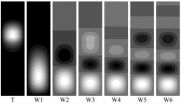(Press-News.org) PHILADELPHIA — A new computational model that simulates bone metastasis of prostate cancer has the potential to rapidly assess experimental therapy outcomes and help develop personalized medicine for patients with this disease, according to data published in Cancer Research, a journal of the American Association for Cancer Research.
"Bone remodeling is a balanced and extremely well regulated process that controls the health of our bones and the levels of circulating calcium," said Leah M. Cook, Ph.D., postdoctoral fellow in the Department of Tumor Biology at the Moffitt Cancer Center in Tampa, Fla. "Active prostate cancer cells in the bone environment can speak the same language of the bone remodeling cells, and disrupt the delicate bone remodeling process. They promote extensive bone destruction and formation that in turn yields nutrients, allowing the prostate cancer cells to grow, thus creating a vicious cycle."
"The mathematical model we created simulates this vicious cycle, and allows us to predict the impact of potential therapies on cancer cells and normal cells of the bone," said Arturo Araujo, Ph.D., postdoctoral fellow in the Department of Integrated Mathematical Oncology at the Moffitt Cancer Center. "Unlike biological models, we can freeze the mathematical model at any time point in order to explore what each cell is doing at that particular point in time."
To create the computational model, which they call "hybrid cellular automata," Araujo, Cook, and colleagues created simulations of different cell types involved in bone metastasis of prostate cancer, including two types of bone cells called osteoclasts and osteoblasts, and prostate cancer cells. They then created algorithms to simulate the interactions of these cells among themselves and with other bone metastasis-related factors in the microenvironment, including the proteins TGF-beta, RANKL, and other bone-derived factors.
The researchers found that when they introduced a single metastatic prostate cancer cell to the model, it was able to simulate bone metastasis seven out of 25 times, accurately creating the vicious cycle. This phenomenon is difficult to reproduce using preclinical animal models, which is critical in determining the best time to apply therapies in order to obtain maximum efficiency, explained Araujo.
Further, the fact that the model failed to generate a bone lesion 18 out of 25 times reflects reality, where not every metastatic cancer cell that invades bone in prostate cancer patients succeeds in forming a viable lesion, he added.
In parallel to developing the computational model, the researchers grew prostate cancer cells that metastasize to bone in mice and found that the tumor growth rate predicted by the computational model was comparable to the tumor growth rate in mice, thus validating their simulations. The model was also able to identify some critical players and events in the process of bone metastasis.
To test if the model could predict treatment outcomes, they applied two standard-of-care treatments, bisphosphonates and an anti-RANKL therapy, and found that the anti-RANKL therapy fared better than bisphosphonates, which is what is seen in prostate cancer patients with bone metastasis treated with these therapies, according to Araujo. The model predicted that improving the efficacy of anti-RANKL delivery to the prostate cancer-bone microenvironment might yield better outcomes.
With further improvements, the model can be individualized to determine personalized medicine for prostate cancer patients, Araujo noted.
"By integrating mathematics with robust biological data, we are beginning to develop powerful tools that allow us to rapidly assess how factors contribute to prostate cancer progression in bone," said Araujo. "Ultimately, we feel that the ability to customize these models based on inputs from each patient's cancer biopsy will help medical oncologists determine the best treatment strategies, so that significant improvements in survival and quality of life can be made."
INFORMATION:
This study was funded by the U.S. Department of Defense and the National Cancer Institute. Araujo and Cook declare no conflicts of interest.
Follow the AACR on Twitter: @AACR
Follow the AACR on Facebook: http://www.facebook.com/aacr.org
About the American Association for Cancer Research
Founded in 1907, the American Association for Cancer Research (AACR) is the world's oldest and largest professional organization dedicated to advancing cancer research and its mission to prevent and cure cancer. AACR membership includes more than 34,000 laboratory, translational, and clinical researchers; population scientists; other health care professionals; and cancer advocates residing in more than 90 countries. The AACR marshals the full spectrum of expertise of the cancer community to accelerate progress in the prevention, biology, diagnosis, and treatment of cancer by annually convening more than 20 conferences and educational workshops, the largest of which is the AACR Annual Meeting with more than 18,000 attendees. In addition, the AACR publishes eight peer-reviewed scientific journals and a magazine for cancer survivors, patients, and their caregivers. The AACR funds meritorious research directly as well as in cooperation with numerous cancer organizations. As the Scientific Partner of Stand Up To Cancer, the AACR provides expert peer review, grants administration, and scientific oversight of team science and individual grants in cancer research that have the potential for near-term patient benefit. The AACR actively communicates with legislators and policymakers about the value of cancer research and related biomedical science in saving lives from cancer. For more information about the AACR, visit http://www.AACR.org.
New model can predict therapy outcomes in prostate cancer with bone metastasis
2014-05-01
ELSE PRESS RELEASES FROM THIS DATE:
Vitamin D deficiency may be linked to aggressive prostate cancer
2014-05-01
PHILADELPHIA — Vitamin D deficiency was an indicator of aggressive prostate cancer and spread of the disease in European-American and African-American men who underwent their first prostate biopsy because of abnormal prostate-specific antigen (PSA) and/or digital rectal examination (DRE) test results, according to a study published in Clinical Cancer Research, a journal of the American Association for Cancer Research.
"Vitamin D is a steroid hormone that is known to affect the growth and differentiation of benign and malignant prostate cells in prostate cell lines and ...
Human fat: A trojan horse to fight brain cancer?
2014-05-01
Johns Hopkins researchers say they have successfully used stem cells derived from human body fat to deliver biological treatments directly to the brains of mice with the most common and aggressive form of brain tumor, significantly extending their lives.
The experiments advance the possibility, the researchers say, that the technique could work in people after surgical removal of brain cancers called glioblastomas to find and destroy any remaining cancer cells in difficult-to-reach areas of the brain. Glioblastoma cells are particularly nimble; they are able to migrate ...
Crocodile tears please thirsty butterflies and bees
2014-05-01
The butterfly (Dryas iulia) and the bee (Centris sp.) were most likely seeking scarce minerals and an extra boost of protein. On a beautiful December day in 2013, they found the precious nutrients in the tears of a spectacled caiman (Caiman crocodilus), relaxing on the banks of the Río Puerto Viejo in northeastern Costa Rica.
A boat carrying students, photographers, and aquatic ecologist Carlos de la Rosa was passing slowing and quietly by, and caught the moment on film. They watched [and photographed] in barely suppressed excitement for a quarter of an hour while the ...
Competition of the multiple Gortler modes in hypersonic boundary layer flows
2014-05-01
The present study illustrates, for the hypersonic flows, through the local and marching analysis, the crossover of the mode W and the mode T at O(1) wavenumber and large Görtler number regime. In fact, it is at this wavenumber regime that the instability is most likely to occur. The two approaches are expected to deliver similar results and the marching analysis helps to express the details of the crossover and confirm the result of the local analysis.
In fact the study of Görtler instability goes back to the date of the 1940s. Since Görtler's pioneering investigation ...
Vitamin D deficiency linked to aggressive prostate cancer
2014-05-01
CHICAGO --- African-American and European-American men at high risk of prostate cancer have greater odds of being diagnosed with an aggressive form of the disease if they have a vitamin D deficiency, according to a new study from Northwestern Medicine® and the University of Illinois at Chicago (UIC).
Results of the study will be published May 1 in Clinical Cancer Research, a journal of the American Association for Cancer Research.
"Vitamin D deficiency could be a biomarker of advanced prostate tumor progression in large segments of the general population," said Adam ...
Extreme sleep durations may affect brain health in later life
2014-05-01
BOSTON, MA – A new research study led by Brigham and Women's Hospital (BWH) published in The Journal of the American Geriatrics Society in May, shows an association between midlife and later life sleeping habits with memory; and links extreme sleep durations to worse memory in later life. The study suggests that extreme changes in sleep duration from middle age to older age may also worsen memory function.
"Sleep Duration In Midlife and Later Life In Relation to Cognition: The Nurses' Health Study," led by Elizabeth Devore, ScD, instructor in medicine in the Channing ...
New UT Arlington research could improve pharmaceuticals testing
2014-05-01
A UT Arlington chemistry professor, renowned for his work in the area of chemical separations, is leading an effort to find a more accurate way to measure water content in pharmaceuticals – a major quality issue for drug manufacturers.
Daniel W. Armstrong, UT Arlington's Robert A. Welch Chair in Chemistry, says the new technique could be 100 times more sensitive than one of the most popular current methods.
"The analysis for water in many consumer products, including drugs, is one of the most required tests done in the world," said Armstrong. "Current methods have many ...
Playing pool with carbon atoms
2014-04-30
A University of Arizona-led team of physicists has discovered how to change the crystal structure of graphene, more commonly known as pencil lead, with an electric field, an important step toward the possible use of graphene in microprocessors that would be smaller and faster than current, silicon-based technology.
Graphene consists of extremely thin sheets of graphite: when writing with a pencil, graphene sheets slough off the pencil's graphite core and stick to the page. If placed under a high-powered electron microscope, graphene reveals its sheet-like structure ...
Ground breaking technique offers DNA 'Sat Nav' direct to your ancestor's home 1,000 years ago
2014-04-30
Tracing where your DNA was formed over 1,000 years ago is now possible due to a revolutionary technique developed by a team of international scientists led by experts from the University of Sheffield.
The ground breaking Geographic Population Structure (GPS) tool, created by Dr Eran Elhaik from the University of Sheffield's Department of Animal and Plant Sciences and Dr Tatiana Tatarinova from the University of Southern California, works similarly to a satellite navigation system as it helps you to find your way home, but not the one you currently live in – but rather ...
Cutting cancer to pieces: New research on bleomycin
2014-04-30
A variety of cancers are treated with the anti-tumor agent bleomycin, though its disease-fighting properties remain poorly understood.
In a new study, lead author Basab Roy—a researcher at Arizona State University's Biodesign Institute—describes bleomycin's ability to cut through double-stranded DNA in cancerous cells, like a pair of scissors. Such DNA cleavage often leads to cell death in particular types of cancer cells.
The paper is co-authored by professor Sidney Hecht, director of Biodesign's Center for BioEnergetics. The study presents, for the first time, alternative ...



